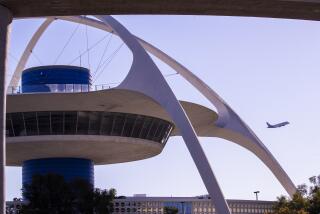Official Quotes Pilot on Aborted Takeoff
- Share via
NEW YORK — The pilot of an airliner that veered off a runway and erupted in flames told investigators Friday he aborted the takeoff when a warning system indicated engines were stalling, a federal official said.
The Trans World Airlines pilot had no indication there was a fire until after he aborted the liftoff at John F. Kennedy International Airport, John Lauber, a National Transportation Safety Board investigator, said at a news conference.
All 292 people aboard escaped through emergency exits as flames engulfed the back half of the plane. Fifty-five people were hurt, none seriously. TWA Flight 843, a Lockheed-built L-1011, had been headed to San Francisco.
Passengers told investigators that the plane lifted off the ground from two feet to 100 feet before pilot William Shelby Kinkead aborted the flight, Lauber said.
He quoted the pilot as saying: “The airplane didn’t feel normal at that point. It didn’t feel like it was going to fly.” Lauber said Kinkead told investigators a warning system indicated engines were stalling.
Air traffic controllers told investigators they saw smoke coming from the plane when it was halfway down the runway and radioed the pilot at about the time of liftoff, Lauber said.
Lauber disputed an earlier report that fuel had leaked from the plane during the takeoff.
The Port Authority’s preliminary report on the accident said a rear fuel line to the plane may have ruptured, causing the fire, said a Port Authority police official who spoke on condition of anonymity.
That report said the plane left a trail of fuel stretching 2,500 feet behind the site where the plane came to rest, the source said.
But Lauber said investigators could find no evidence that any fuel lines broke and found no fuel on the runway.
Earlier Friday, Gregory Feith, an NTSB inspector, said an engine problem may have preceded the fire. But Thomas Conroy, who is heading the investigation for the NTSB, said it was too early to say what the cause was.
Investigators collected and analyzed pieces of wreckage. The plane’s flight and voice recorders were sent to Washington.
The L-1011 has a good safety record, according to aerospace experts. But twice in the past two years L-1011 engines have spurted flames: at Kennedy on April 16, 1992, and at Boston’s Logan Airport on March 26, 1990. No serious injuries were reported in either case.
Passengers who watched from the Tarmac as flames enveloped the rear half of their plane praised the 12-member crew for getting them out.
The crew did “a fabulous job,” said Bill Kistner, a retired police officer from San Jose, Calif.
“People were panicking. We were all trying to get away from the flames,” Kistner said. “The captain was helping everyone out. He was the last to go.”
The Port Authority report said the pilot had walked the length of the aircraft to make sure everyone was out before he disembarked.
“The evacuation went extremely well,” agreed Frank Huever, chief supervisor of operations for the Port Authority, which runs the airport. “The pilot really knew what he was doing.”
Kinkead has flown with TWA since 1965 and for the Air Force before then, said family members at his home in Road Town, Tortola, in the British Virgin Islands.
More to Read
Sign up for Essential California
The most important California stories and recommendations in your inbox every morning.
You may occasionally receive promotional content from the Los Angeles Times.












